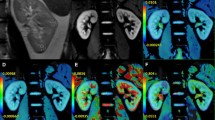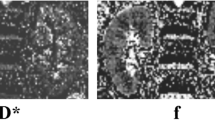Abstract
Purpose
Magnetic resonance diffusion-weighted imaging (MR-DWI) is useful to assess proton motion by the computation of an apparent diffusion coefficient (ADC). This property could be used to assess renal damage, with special regard to unilateral dysfunction. The aim of this study was to estimate the correlation between ADC and the stage of chronic renal failure (CRF) using a spin-echo echo-planar imaging (SE-EPI) sequence with the sensitivity encoding (SENSE) technique.
Materials and methods
Fourteen patients (nine men and five women, mean age 49 years, range 22–66 years) underwent an MR examination on a 1.5-T system. Seven patients had a history of hypertension or CRF, one had Takayasu disease and one had nephrovascular hypertension. Five subjects without known kidney disease were used as controls. The glomerular filtration rate (GFR) assessed by Cockcroft-Gault’s equation was used as a functional marker. The imaging protocol consisted of T1- and T2-weighted sequences followed by a SE-EPI acquisition with a diffusion gradient of 600 s/mm2 and SENSE factor 2 and pixel-by-pixel ADC map reconstruction. In five patients, the SE-EPI-DWI sequence was repeated after i.v. administration of 1 mg of furosemide.
Results
ADC was of 2.44±0.24×10−3 mm2/s in patients with normal GFR and of 2.05±0.33×10−3 mm2/s (p<0.05) in subjects with altered GFR; a significant difference was found between stage III and IV (p<0.01), whereas no differences were found between stage I and II (p=0.27) and between stage II and III (p=0.39). A good correlation was found between GFR and ADC (r=0.79; p<0.01), with no significant change after furosemide administration (p=0.7).
Conclusions
DWI is a feasible MR technique for assessing renal damage. Further studies with scintigraphic correlation are needed to confirm these results and to establish reference values for this imaging technique.
Riassunto
Scopo
La risonanza magnetica (RM) in diffusione (diffusion weighted, DW) permette di ottenere dati quantitativi sul movimento dei protoni liberi di acqua determinando il coefficiente di diffusione apparente (apparent diffusion coefficient, ADC). Questa capacità potrebbe essere usata per stabilire il danno parenchimale renale, in particolare nelle disfunzione unilaterali. Scopo del presente lavoro è quello di valutare la correlazione tra ADC e grado di insufficienza renale cronica utilizzando una sequenza SE Eco-planare (SS-EPI) a cui è stato applicato la tecnica di SENSitivity Encoding (SENSE).
Materiali e metodi
Quattordici pazienti (9 maschi e 5 femmine, età media 49 anni, range 22–66) sono stati sottoposti ad esame RM con sistema ad alto campo 1,5 T; in 5 pazienti non vi erano dati anamnestici e bioumorali di nefropatia, mentre in 7 era presente storia di ipertensione arteriosa e/o IRC ingravescente, in 1 di malattia di Takayasu e in 1 di ipertensione nefrovascolare. Il protocollo prevedeva acquisizioni T1 e T2 dipendenti, nonché una sequenza SE-EPI pesata in diffusione (b-factor 600 s/mm2) con fattore SENSE 2 e ricostruzione di mappe dell’ADC. In 5 casi la SS-EPI-DW è stata ripetuta dopo somministrazione di furosemide. Il filtrato glomerulare è stato ottenuto mediante metodo di Cockroft-Gault.
Risultati
L’ADC nei soggetti normali ed i pazienti in stadio I è stato di 2,44±0,24×10−3 mm2/s, mentre quello dei pazienti in stadio II–IV è stato di 2,05±0,33×10−3 mm2/s (p<0,05). Non è stata rilevata una differenza significativa dell’ADC tra stadio I e stadio II (p=0,27) e tra stadio II e stadio III (p=0,39), mentre la differenza è stata significativa tra pazienti in stadio III e IV(p<0,01). Si è rilevata una significativa correlazione tra la clearance della creatinina (ClCr(CG)) e l’ ADC parenchimale (r=0,79; p<0,01). La furosemide non ha determinato modificazioni dell’ADC (p=0,7).
Conclusioni
La RM-DW permette di ottenere valori quantitativi del coefficiente di diffusione correlabili con la funzione renale separata, senza somministrare mezzo di contrasto e con rapidi tempi d’esame. Ulteriori studi di correlazione con i dati scintigrafici e su più ampie casistiche sono necessari al fine di confermare tali risultati e stabilire valori di riferimento per questa metodica.
Similar content being viewed by others
References/Bibliografia
De Vecchi AF, Dratwa M, Wiedemann ME (1999) Healthcare systems and end-stage renal disease (ESRD) therapies. An international review: cost and reimbursement/funding of ERSD therapies. Nephrol Dial Transplant 14[Suppl 6]:31–41
Foley RN, Parfrey PS, Sarnak MJ (1998) Clinical epidemiology of cardiovascular disease in chronic renal disease. Am J Kidney Dis 32:S112–S119
Fleischmann D (2003) MDCT of renal and mesenteric vessels. Eur Radiol 13[Suppl 15]:94–101
Kapoor A, Mahajan G, Singh A, Sarin P (2004) Multispiral computed tomographic angiography of renal arteries of live potential renal donors: a review of 118 cases. Transplantation 77:1535–1539
Zhang H, Prince MR (2004) Renal MR angiography. Magn Reson Imaging Clin N Am 12:487–503
Riccabona M, Ruppert-Kohlmayr A, Ring E et al (2004) Potential impact of pediatric MR urography on the imaging algorithm in patients with a functional single kidney. AJR Am J Roentgenol 183:795–800
Grenier N, Basseau F, Ries M et al (2003) Functional MRI of the kidney. Abdom Imaging 28:164–175
Thoeny HC, De Keyzer F, Oyen RH et al (2005) Diffusion-weighted MR imaging of kidneys in healthy volunteers and patients with parenchymal diseases: Initial experience. Radiology 235:911–917
Colagrande S, Pallotta S, Vanzulli A et al (2005) Il parametro “diffusione” in risonanza magnetica: elementi di fisica, tecnica e semeiotica. Radiol Med 109:1–16
Taouli B, Martin AJ, Quayyum A et al (2004) Parallel imaging and diffusion tensor imaging for diffusion weighted MRI of the liver: preliminary experience in healthy volunteers. AJR Am J Roentgenol 183:677–680
Bammer L (2003) Basic principles of diffusion weighted imaging. Eur J Radiol 45:169–184
Pruessmann KP, Weiger M, Scheidegger MB et al (1999) SENSE: sensitivity encoding for fast MRI. Magn Reson Med 42:952–962
Namimoto T, Yamashita Y, Mitsuzaki K et al (1999) Measurement of apparent diffusion coefficient in diffuse renal disease by diffusion weighted echoplanar MR imaging. J Magn Reson Imaging 9:832–837
Mc Cullough PA (2003) Beyond serum creatinine: defining the patient with renal insufficiency and why? Rev Cardiovasc Med 4[Suppl 1]:S2–S6
Le Bihan D, Breton E, Lallemand D et al (1986) MR imaging of intravoxel incoherent motions: application to diffusion and perfusion in neurologic disorders. Radiology 161:401–407
Vallée JP, Lazeyras F, Khan HG et al (2000) Absolute renal blood flow quantification by dynamic MRI and Gd-DTPA. Eur Radiol 10:1245–1252
Murtz P, Flacke S, Träber F et al (2002) Abdomen: Diffusion-weighted MR imaging with pulse-triggered single-shot sequences. Radiology 224:258–264
Fukuda Y, Ohashi I, Hanafusa K et al (2000) Anisotropic diffusion in kidney: apparent diffusion coefficient measurements for clinical use. J Magn Reson Imaging 11:156–160
Yamada I, Aung W, Himeno Y et al (1998) Diffusion coefficients in abdominal organs and hepatic lesions: evaluation with intravoxel motion echoplanar MR imaging. Radiology 210:617–623
Carbone SF, Cappellini M, Antonello M et al (2003) Feasibility of diffusion-weighted MR Imaging in pediatric abdomen: preliminary report. Pediatr Radiol 33[Suppl 2]:S30
Cova M, Squillaci E, Stacul F et al (2004) Diffusion-weighted MRI in the evaluation of renal lesions: preliminary results. Br J Radiol 77:851–857
Ries M, Basseau F, Tyndal B et al (2003) Renal diffusion and BOLD MRI, in experimental diabetic nephropathy. Blood oxygen level-dependent. J Magn Reson Imaging 17:104–113
Bammer R, Feeling SL, Augustin M et al (2001) Improved diffusion-weighted single-shot echo-planar imaging (EPI) in stroke using sensitivity encoding (SENSE). Magn Reson Med 46:548–554
Author information
Authors and Affiliations
Corresponding author
Rights and permissions
About this article
Cite this article
Carbone, S.F., Gaggioli, E., Ricci, V. et al. Diffusion-weighted magnetic resonance imaging in the evaluation of renal function: A preliminary study. Radiol med 112, 1201–1210 (2007). https://doi.org/10.1007/s11547-007-0217-6
Received:
Accepted:
Published:
Issue Date:
DOI: https://doi.org/10.1007/s11547-007-0217-6




